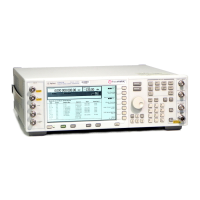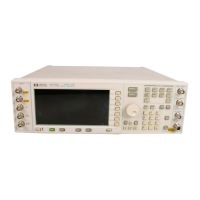450 Chapter 16
W-CDMA Uplink Digital Modulation for Receiver Test
Understanding the PRACH
slots to set the timing/distance between preamble transmissions (Tp-p) and the preamble and the message
part (Tp-m). Figure 16-3 shows these timing relationships. You will notice that all measurements are from
the beginning of one component to the next.
Figure 16-3 Access Slot Timing
The preamble is 4096 chips in length (1.067 ms), so it does not occupy the entire length of an access slot.
When a 10 ms message part (7.5 access slots) is used, it only partially occupies the last access slot.
In multiple PRACH mode, the ESG provides you access slot resolution. Because of this, you can select the
access slot for the beginning of your PRACH transmission. However when transmitting multiple PRACHs
for the same UE with the ESG, they cannot occupy any of the same access slots within an 80 ms time period.
If they do, the subsequent (second PRACH, etc.) PRACH transmission that uses any of the same access
slots, will not occur. See “Understanding the 80 ms Transmission/Time Period” on page 474 for more
information.
Preamble
The preamble is used to signal a base station that a UE is trying to establish communications. It is composed
of a complex signature and scrambling code that is used by the base station to uniquely identify the UE. This
is a 1.067 ms bursted signal, and is the first part of the PRACH transmission.
Signatures
A signature is a series of 16 bits that is repeated 256 times within a single preamble. These signatures are
shown in the 3GPP standards. The signature is the first of two parts used in the spreading of the preamble. It
points to a node within the channelization codes that corresponds to a spread factor (SF) of 16. This node,
Tp-a
Preamble
AICH
Tp-m
Message Part
AICH Access
Slots RX at UE
PRACH Access
Slots TX at UE
Tp-p
One Access Slot

